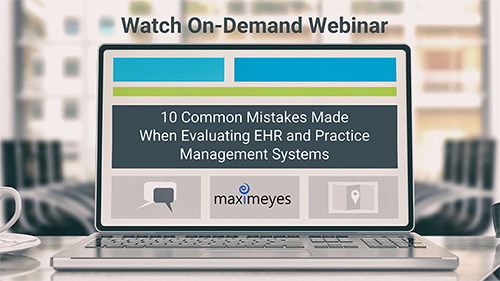
03 Jun 10 Mistakes to Avoid When Evaluating Eye Care Software
There are wide variations in how different EHR and practice management eye care software systems help you capture and view patient data, just like there are differences in how optometrists deliver care to patients.
As the most expensive human resource (the doctor) in your practice, you need an efficient EHR system that allows you to be as productive as possible.
Your EHR software needs to quickly transfer data out of the patient exam so your staff can complete critical job functions. In addition, the entire office needs optometry software that is easy to learn and use with minimal screen jumping and mouse clicks.
Let’s review ten common mistakes we’ve seen too many optometrists make when evaluating eye care software.
1. Not defining your key needs and deal-breakers up front before scheduling any optometry EHR and practice management demos.
- Identify the top five things that are not working for you and your staff with your current eye care software.
- Ask vendors to show you (not simply explain) how their system can solve the problems you are currently experiencing in your current system.
- Make a wish list of features you’d like to see during the demo. Look at patient workflows and office processes to prepare a list of questions to ask the vendors during your demos.
- Narrow your EHR software selection down to the top three products before you schedule demos. If you don’t find a system you like among those three, you can always schedule more demos. But if you try to schedule too many demos, you may lose track of the pros and cons of each product over time.
- Try to schedule live software demos in the same two to three-week window—it’s much easier to compare.
- Ask questions during the demo and email follow-up questions to the vendors within a few days.
“We tried converting our data to another EHR vendor, and that vendor could not convert the data correctly. Their system was too complicated for my staff, and the changes were met with a lot of resistance. With MaximEyes.com, the implementation, workflow, and business process are very straightforward.” –Chet Myers, OD
2. Not getting a detailed price quote.
- Get a written, itemized quote (not estimates) with a clear description of what modules or features are included. A quote is an exact price that often can’t be changed once the customer accepts it unless the customer requires additional services outside the scope of the original quote the customer agreed to.
- Ask the sales representative to provide pricing for all add-on options, too. You don’t want to be surprised by add-on options and fees later.
- Don’t rely on a verbal quote or dollar amount via text or email. Instead, insist on a detailed quote that is easy to understand.
3. Failing to get answers to questions in writing.
- Email your critical questions to the sales rep and insist on clear, unambiguous responses.
- Competent sales reps want to be clear about what the product can or cannot do.
- A good customer-product fit is mutually beneficial to you and the vendor.
4. Not asking for access to a sandbox.
- Ask your EHR vendor to allow you time to play around in a software sandbox (a live-working version of the software) before making a final decision. There can be a huge difference between watching a guided demo vs. hands-on experience with the software.
- When in the sandbox, see how easy or intuitive the software is to navigate without any training.
- If a vendor refuses to give you access to a sandbox to play with the software, move on to other vendors who actually want to know if you are a good candidate for their software.
5. Forgetting to ask about the onboarding process.
- Ask what the typical tasks and timelines for a successful implementation are.
- Ask if the software vendor provides live online training during the onboarding and implementation process or just videos.
- Ask what resources are available in the software to help you learn how to use it: videos, documents, courses, step-by-step walkthroughs, and integrated learning management tools.
- Ask what is the cost for additional training, if needed.
“Our EHR data conversion and implementation process were very smooth and easy. The implementation checklists, onboarding sheets, and updates were extremely helpful.” –Peter Falk, OD
6. Relying on recommendations from non-users of the EHR software.
- Online software review “services” are clearinghouses that gather information on different EHR and practice management products. They are not experts on the software and they have never used it. They make a profit by selling your contact information to any software vendor who will pay them for the lead.
- Some software vendors also pay industry consultants and third-party sales reps for referring doctors to them. If you receive a recommendation from someone who isn’t using the software, ask them if they receive any financial incentives.
7. Trusting what one EHR vendor tells you about a competitor’s product.
- An EHR and practice management eye care software competitor is not the most reliable source to comment on features in a competitor’s product. There is no way a sales rep can stay up-to-date on which features are included in all of the competitors’ products or how well those features perform.
- Ask each vendor to focus on what it believes are its key differentiators vs. talking negatively about a competitor’s product or company. This will allow you to know what that vendor considers its strengths to be vis-à-vis its competition.
8. Not asking what data you will receive if or when you move to another software.
- Ask each vendor if you will receive all of your patient data in an electronic format suitable for data conversion to another product should you ever decide to leave that vendor.
- Beware, as some vendors provide your exam data in a PDF format only if you leave them. These PDFs are nearly useless for transitioning to a new EHR since none of the data is electronic. This means that none of your exam data can be copied forward into today’s encounter, and it forces you to toggle back and forth between the PDF files and the EHR for data entry, which is very inefficient.
- Keep in mind that some vendors will charge exorbitant fees to provide you with your data on exit. Ask about those fees before you buy. Look at the fine print regarding this in any contract before you sign.
- Whether you are converting paper records to electronic records or transitioning from one EHR to another, allow plenty of time for migrating and testing your data in your new EHR system. Make sure your new vendor provides a test data conversion for you to inspect before the final data conversion so any errors or missing data can be corrected or captured in the final data conversion.
“We tried converting our data to another EHR vendor, and that vendor could not convert the data correctly. Also, their system was too complicated for my staff, and the changes were met with a lot of resistance.” –Chet Myers, OD
9. Beware of long-term contracts and short trial periods before you lock in.
- Confirm if there is an easy-out clause (30 or 60 days) that can be triggered anytime during the first year.
- Don’t accept contracts that lock you in for more than 12 months. You probably will not even know if the software will meet your needs until you are at least six months into using it.
10. Not checking into the company management, engineering, and support teams.
Ask these questions of each vendor and compare the responses:
- How long has the company been in business?
- Who is on the management team, and what is their experience in the eye care industry?
- How large is its software development team?
- Are customer support and satisfaction stats available?
Helping You Evaluate Eye Care Software: Watch Our On-Demand Webinar
Did you miss our virtual event? Watch the on-demand webinar whenever you want. In less than 20 minutes, learn how to avoid the most common pitfalls of evaluating and selecting EHR and practice management eye care software for your office.






